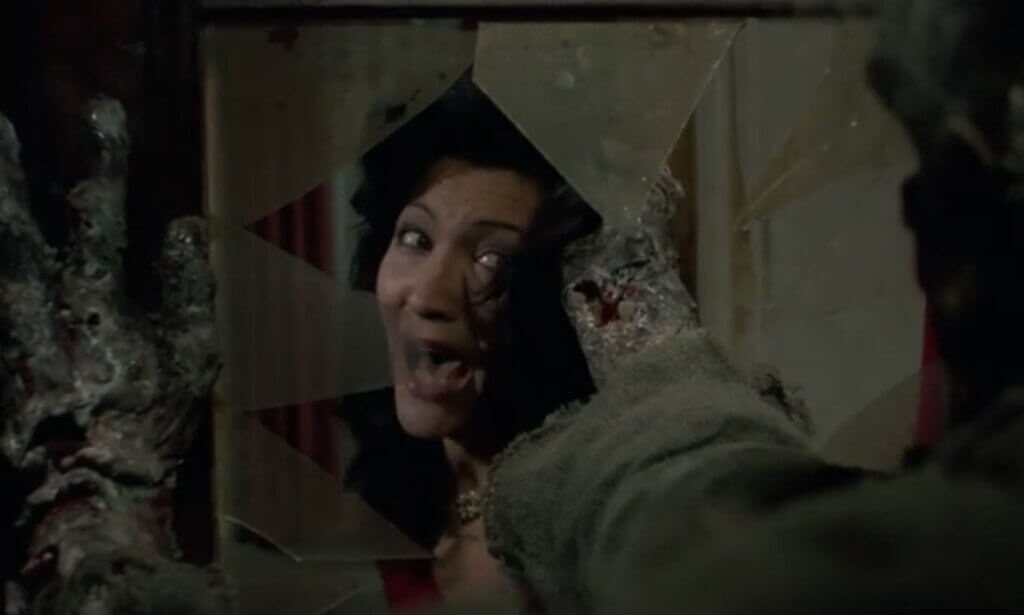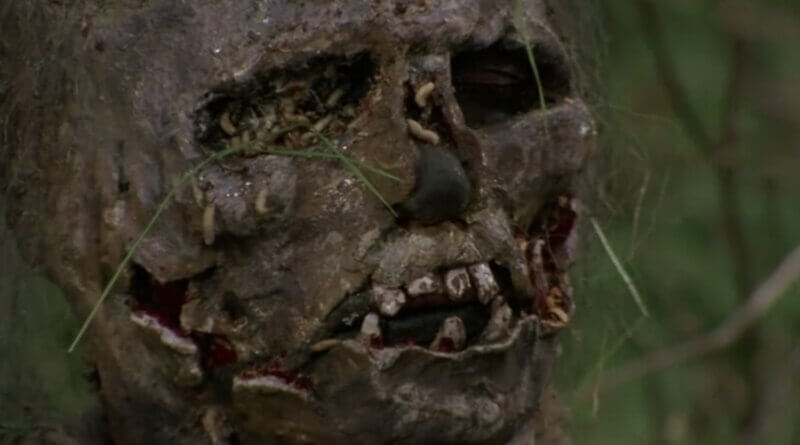Burial Ground: The Nights of Terror (1981), Slow Zombies Kill Weird People
While modern zombie films have accustomed viewers to lightning-fast creatures hunting down the living, there was once a time when zombies were notoriously slow. In fact, it was the norm. However, in Andrea Bianchi’s Burial Ground: The Nights of Terror (1981), which has gone by dozens of different names over the years, the zombies slow down to a near standstill. Unfortunately, this makes the film’s central antagonists untenable, while also making the pacing and plot equally placid.
Though it is easy to get hung up on the unreasonably slow zombies that would pose no threat in the real world, there are so many other elements in Burial Ground that provide more questions than answers. However, before I get into the most bizarre aspects of Andrea Bianchi’s grindhouse zombie film, I have to provide you with some context. For all of its faults and the many reviewers who have lambasted the film for its lack of plot, there is a story somewhere in there.
Burial Ground opens with some kind of archeologist or scientist or religious scholar trying to figure out the secrets hidden in the crypts below a lavish mansion. As one can imagine, his work quickly unleashes an evil curse that brings the dead back to life. Despite moving at a snail’s pace, the dead overtake him, but not before he is able to invite a group of his friends to the mansion to discuss his latest discoveries.
Three couples arrive at the mansion, as well as the “child” of one of the couples. This “child” is likely meant to be no more than 8 or 9 years old, but he is played by Pietro Barzocchini (credited as Peter Bark), an Italian actor who was about 25 years old at the time of filming. Therefore, you have someone who is very clearly an adult, albeit somewhat small and boyish for his age, playing a much, much younger character by the name of Michael.

On top of that, Michael’s characterization is odd from top to bottom. He is directed to provide very little dialogue. Instead, he just stares off into space with wide-eyed terror for seemingly no reason. When he inadvertently walks in on his mother, Evelyn (Mariangela Giordano), having sex with her partner, it seems to traumatize him to no end. He also watches other couples having sex, as do we. The entire thing is very Freudian, but without any rhyme or reason.
In any case, the couples enjoy the pleasures of the mansion and wonder why their host, the scientist, has yet to appear. Soon after, the mansion is attacked by a horde of really, really slow zombies. The couples barricade themselves inside with the help of the staff. However, the zombies quickly evolve, learning how to use tools like axes and pitchforks to break down the makeshift barriers. The situation grows increasingly dire, even though the speed of zombies (or lack thereof) would have provided the characters with ample time to escape if they had really tried.
Meanwhile, the creepy man-child, Michael, develops an attraction to his mother, to the point of fondling her, kissing her, and asking to feed on her breasts. His voice-over is done in such a way that he sounds like a children’s doll every time he says “mama,” which makes it all the more strange. Naturally, Evelyn spurns his advances and slaps Michael, causing him to run off somewhere into the mansion.
The rest of the story unfolds with a series of uninteresting and implausible setpieces, with each character getting torn to pieces one by one. Again, the zombies don’t really do all that much. Instead, the camera zooms in on lifeless skulls with maggots coming out of their nostrils and eye sockets. The story does not really move in any satisfying direction. However, the film is most infamous for a scene that takes place in the final minutes, so it may be worth the wait to see the whole thing through to the end. Let’s just say that there is a zombified breastfeeding moment that goes about as well as one could imagine.

Even if you ignore the strange Freudian subplots, lack of pacing, and directionless plot, it is impossible to ignore the slow zombies. At one point in the film, one of the characters actually says something along the lines of “these zombies are really slow, so we can just outrun them.” And yet, they don’t. They scream and build barriers that don’t work and wait to get killed. Eventually, some of the characters sneak out of the mansion, only to encounter even slower, unjustifiably deadly zombies.
Burial Ground was clearly an attempt to cash in on the Italian zombie movie craze and the success of some of its predecessors, like Zombi and Zombi 2. However, one could argue that the complete lack of vision and poor pacing inadvertently killed a genre movement that could have continued for another decade. Despite being funny (though not in the way zombie comedies should be) for its bizarre casting and weird, violently sexual encounters, Burial Ground really has nothing to offer. Even the death scenes are repetitive, with each respective victim getting their stomachs opened so that zombies with subpar makeup can pretend to eat their entrails.
In short, there are only a few reasons to actually sit through Burial Ground: The Nights of Terror (1981). If you’re a fan of Italian grindhouse horror, then this film might scratch that itch. Moreover, if you’re like me and you find it hilarious when adult actors play child characters very poorly, then you may get a few laughs from it. In the case of the latter viewers, you will also get to see some really bizarre, unsettling, and incestuous mother-son bonding.
Burial Ground: The Nights of Terror (1981) Movie Rating: ★½ out of 5
If you’d like to watch Burial Ground: The Nights of Terror (1981), it is currently available to rent or purchase via Amazon. For more film reviews like this one, be sure to check out the Philosophy in Film homepage.

